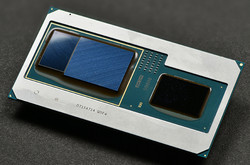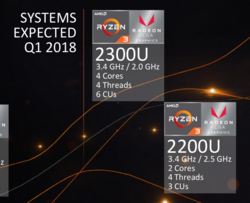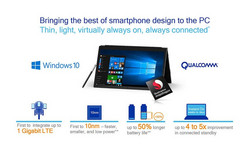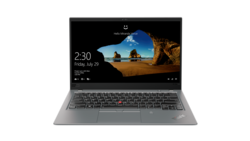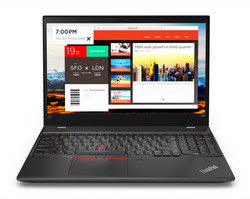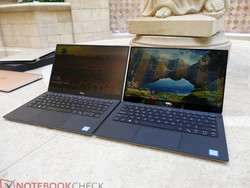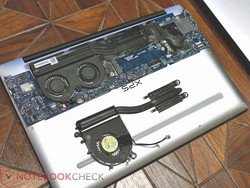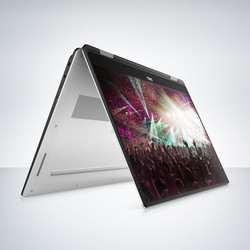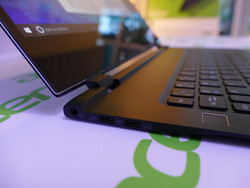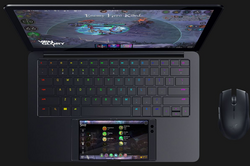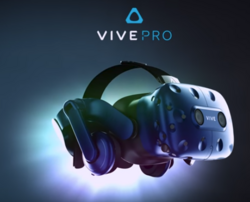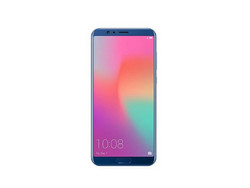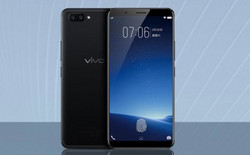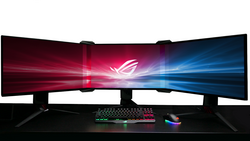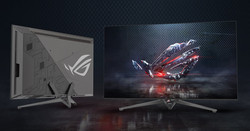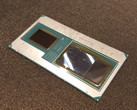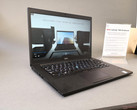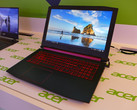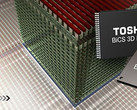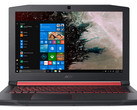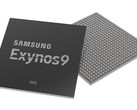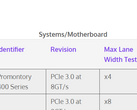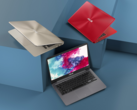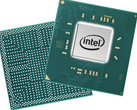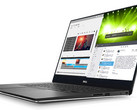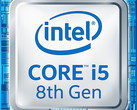CES 2018: Our impressions of the biggest show of the year
Introduction
When it comes to tech shows, few can match the grandeur and extravaganza of CES. While the show aims to showcase the latest innovations and the best of what OEMs have to offer in various categories, it is also a perfect platform to understand the trends the industry tends to gravitate towards in the months to come. At this year's CES in Las Vegas, many products were showcased, and at Notebookcheck, we got the chance to get a first hand look at these new offerings and understand their implications in shaping the technology landscape this year. Let's take a look at some of the most impressive products we saw at the show category by category.
Notebooks
We were obviously excited by the prospects of some of the new notebook models expected to make their debut this year. We'll take you through some of the noteworthy stuff we saw first hand.
CPU and GPU Tech
Undeniably, the most important hardware announcement to come out of CES 2018 was the Intel 8th generation 'Kaby Lake-G' family of CPUs featuring an onboard custom Radeon RX Vega GPU. The 'Kaby Lake-G' sits right between the U-series CPUs geared towards mainstream mobility and the H-series chips focused more on performance. With up to 24 Compute Units (CUs), the onboard Radeon RX Vega GPU provides enough muscle to wade through graphically intensive tasks. The overall package is much more space saving compared to a traditional CPU + dGPU combination and thus, enables thinner and lighter form factors. With the ability to drive up to a total of nine 4K displays and a dynamic power sharing framework between the CPU and the GPU, the 'Kaby Lake-G' has the potential to be a much sought-after package among OEMs. This much awaited announcement was also closely shadowed by concerns regarding the recent Meltdown and Spectre exploits that had the whole industry on its feet. Intel CEO, Brian Krzanich, emphasized in his keynote address the measures taken by Intel to proactively address the security concerns surrounding its chips. While we've seen mixed results in the wild, we're at least glad that chipmakers are considering this to be a top priority.
This year, we expect to see some tough competition from the likes of AMD and Qualcomm who are leaving no stone unturned to put pressure on Intel. AMD had a successful Ryzen launch last year and its new laptop CPUs are churning out good numbers in comparison with Intel's more powerful and costlier offerings. Ryzen 3 Mobile is aimed to further lower the entry-level bar and will offer stiff competition to Intel's Core i3 offerings. Then, there's also the discrete Vega Mobile GPU with HBM2 memory that will supposedly rival NVIDIA's Max-Q variants. Speaking of Max-Q, we also saw NVIDIA silently announce the GTX 1050 Max-Q and the 1050 Ti Max-Q as a possible answer to Intel's 'Kaby Lake-G'. The combination of Ryzen Mobile with discrete Radeon Vega mobile has the potential to challenge Intel in offering true bang for buck per watt.
AMD is also courting the enterprise segment with its Ryzen Pro APU lineup offering chip-level security features in addition to the consumer features. The recent barrage of Intel's issues with enterprise security might see businesses start considering AMD chips for deployment.
Qualcomm isn't resting on its laurels either, and 2018 will be the year of the always-connected notebook. Expect new devices sporting the Snapdragon 835 soon. The upcoming Snapdragon 845 SoCs didn't show up at CES in laptops so far, but should come later this year. These will come with support for the full Windows 10 on ARM version and can run traditional Win32 apps alongside UWP apps with a battery life north of 22 hours. We saw the Asus NovaGo, Lenovo Miix 630, and the HP Envy x2 as new competitors to Intel-based designs. All of them sported the Snapdragon 835 SoC, a minimum of 4 GB RAM and 128 GB UFS storage, and always-on 4G LTE connectivity. While all this is great on paper and the notebooks are indeed sleek to look at, the entry price point (currently starting from US $800) could be a deterrent in mass adoption of these devices given that there are more powerful alternatives available in that price range.
Lenovo
Lenovo had announced some revisions to its ThinkPad lineup. The most notable of them was the ThinkPad X1 Carbon. The X1 Carbon finally joins the legions sporting the 8th generation Intel 'Kaby Lake-R' U-series CPUs albeit a bit late. What we liked about the X1 Carbon is that it does not sacrifice fundamentals in the pursuit of mobility. You get a great screen that is either 4K HDR capable and glossy or full HD, matte and touch-screen. Both sport reduced bezels. While other OEMs have been following Apple in dumping common ports in favor of USB-C, we are glad that Lenovo chose to stick to what has been the norm. In our opinion, this is a move in the right direction as we feel that the market is not fully ready for a USB-C-only future.
Other Lenovo notebooks on display included the ThinkPad T480, T480s, and the T580. These have been mostly incremental upgrades over the last year models — nothing out of the blue here. Other models include the ThinkPad X280 and ThinkPad X380 Yoga. Both have undergone some trimming in dimensions and come with upgraded internals. One sore point was the loss of the Powerbridge flexibility (one internal and user-replacable battery) and full size Ethernet in the ThinkPad X280, which we feel will irk many loyalists. The X380 Yoga is, again, just a rehash of the Yoga 370 with upgraded internals. Apart from these, there were also the L-series ThinkPads, which should offer a low-cost entry point for small businesses.
Dell
Next up, Dell. When Dell announced that it would be refreshing the XPS 13 inside-out, it got everyone excited. Dell touted using exquisite materials for fabricating the chassis of the new XPS 13 9370. We got to play around with the new XPS 13 and also the XPS 15 2-in-1. The XPS 13 comes in classic black and Rose Gold colors. While they felt great to hold, we did find that both models dumped conventional port choices in favor of USB-C.
We hope that the issue of coil whine, which plagued previous XPS 13 models, is now addressed. We are happy for the dual fan setup in the new XPS 13, although, we are still apprehensive about the fact that the XPS 13 9370 uses the same CPU in the XPS 13 9360 and is still 3mm thinner. We look forward to test Dell's new power and thermal management technologies and hope that the laptop does not throttle too much under stress.
The XPS 15 2-in-1 is notable, for it's the first XPS to adopt the new Intel 'Kaby Lake-G' processors with Radeon Vega graphics. While the regular XPS 15 will soon make its mark during Q2 2018, the XPS 15 2-in-1 brings all that power in a convertible form factor. We are not fans of Dell ditching the SD card slot for microSD as many pros still use the SD card format. The all-USB-C philosophy also complicates things a lot. The floating 'Mag-Lev' keyboard that the XPS 15 2-in-1 boasts didn't feel so 'special' in our opinion. The shallow key travel may, in fact, be cumbersome for some people. Dell, however, claims that the new keyboard can take between 12 to 13 million keystrokes before showing signs of degradation.
Acer
When Acer announced that it will be showcasing the slimmest notebook yet at CES, it had our interest piqued. We stopped by Acer's booth to see how the Swift 7 could achieve this distinction. At only 8.99 mm thick, the 2018 Swift 7 did manage to have our attention. The raison d'être for the notebook's thin profile is the passively cooled Intel Core i7-7Y75 CPU, which should suffice for web browsing, basic Office work, and the works. The new Swift 7 comes with a backlit keyboard, a touchscreen, an integrated LTE modem, and a touchpad that can only be tapped but not clicked (sacrificed for the sake of thinness). While the new model is an improvement over its predecessor, it still makes for an expensive proposition at US$1700 considering the CPU.
Mobile and VR Tech
Not a lot of breakthroughs in smartphones and mobile tech were showcased during CES 2018 — we have the Mobile World Congress 2018 coming up in February for all that. However, we did see some noteworthy announcements.
Razer Project Linda
There have been many attempts in transforming the phone into a desktop experience. There was the Ubuntu Phone that featured a Convergence Mode but that idea died when the project was shelved; Microsoft came in with its Continuum feature on Windows 10 Mobile (W10M) that enabled transforming the phone into a desktop. However, with W10M not taking off as expected, Continuum on phones has been orphaned for quite sometime. Samsung implemented similar features in their flagship devices too with the Samsung DeX. However, Project Linda offers a differentiation from the above offerings by turning an Android phone into a full-fledged notebook experience. The concept uses a Stealth-like notebook that has a provision for inserting a Razer smartphone in the trackpad area, which makes the phone double up as a trackpad or a secondary display. Like Razer's Project Valerie, it is still a proof-of-concept and we are not sure of the practical applications. Nevertheless, it is good to see OEMs trying to offer some differentiation in this important use case.
HTC Vive Pro
HTC showed off its Vive Pro headset at CES 2018. The VR headset was not having nothing much to differentiate from the original Vive apart from a much appreciated resolution bump. We got a chance to play Doom VFR on the headset and did enjoy the experience. The increased resolution is a big improvement for the VR experience and the hardware felt quite good overall. Doom VFR however was struggling to port the movements to the Vive in our experience.
Huawei Honor 7X and Honor View 10
Huawei is finally releasing its much touted Honor phones in the US: the mid-range 7X and the almost-flagship V10, aka the View 10. The View 10 can easily give the Mate 10 a run for its money and aims to compete squarely at the OnePlus 5T. The launch of these phones in the US could finally mean that American customers now have more choices when it comes to choosing their smartphone. The exact launch details and carrier partnerships were not yet revealed, though.
Vivo X20 Plus with In-Display Fingerprint Sensor
In-display biometric authentication has been in the works for sometime now and Vivo has earned the distinction of showcasing the first smartphone with the in-display fingerprint sensor. The device was unnamed during the CES event but we now know that it will be called the Vivo X20 Plus UD and is expected to have a January 25 launch. While we didn't spend much time with the device, the in-display sensor works fairly reliably, although, it is definitely not as fast as a standalone capacitive sensor. The technology is currently limited only to AMOLED and OLED displays, and if the in-display technology picks enough steam, we might soon see the transition of more and more phones to OLED and AMOLED displays.
Miscellaneous Tech
There were a few other technologies that caught our attention as well. Notable among them were the Asus bezel-free kit, the NVIDIA 65-inch G-Sync HDR display, and the Mirabook laptop dock.
Asus Bezel-free Kit
The Asus bezel-free kit is a clever way to hide the distracting bezels when multiple monitors are paired together. The kit is a set of vertical mirrors and mounts that refract the light ensuring a seamless transition between the content of one monitor to the other. There is no software or hardware addon required making it a compelling option for those having multiple monitors. However, the pricing indicated by Asus seemed way too expensive and the visual results were not ideal on the showfloor.
NVIDIA 65-inch G-Sync HDR Display
NVIDIA demonstrated its Big Format Gaming Display (BFGD) initiative by showcasing a 65-inch 4K@120 Hz display that supports G-Sync and HDR. Although we were impressed by the display's prowess, it is an expensive and niche product for many. It does not come with a built-in tuner but supports the company's Shield TV that brings together 4K HDR streaming of Amazon Video and Netflix along with the GeForce NOW game streaming service. No word about pricing so far, but from what we have heard, it won't be cheap.
Mirabook Laptop Dock
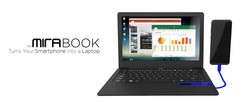
The Mirabook laptop dock is another attempt at turning a smartphone into a laptop. The first version of the laptop was shown during CES 2017 itself but the version at CES 2018 came across as a more refined setup. Featuring a 13.3-inch FHD display, HDMI, USB Type-C, SD card slot and full-day battery life, the Mirabook now supports Samsung DeX, Razer Phone, and Windows 10 Mobile phones that support Continuum. The hardware looked rather promising with a good screen and build quality. It will be interesting to see if smartphone docks will replace some laptops.
Conclusion
On the basis of what we've seen and experienced first hand at CES 2018, we can deduce the following conclusions about how the larger tech landscape will be shaped in 2018:
- The race for thinner chassis with lesser and lesser bezels has only just begun, and we will see more such designs in this year and will continue so for the foreseeable future.
- Security has (rightfully) been a major talking point at this year's CES with all industry leaders pledging for more proactive security measures.
- Intel cannot afford to pick up slack on the innovation front, and its rivals such as AMD and Qualcomm will try everything in their book to snatch as large a piece as possible of Intel's marketshare across desktops and laptops.
- We will see more capable GPU offerings in thin-and-light form factors thanks to the impetus given by the new Intel 'Kaby Lake-G' chips. NVIDIA's 1050/Ti Max-Q is a step in that direction.
- Convertibles and 2-in-1s are here to stay and will only get better and more powerful — a fact proven by the new Dell XPS 15 2-in-1 and the HP Spectre x360.
- Always-connected PCs and smartphones morphing into laptops could pick up steam given that many OEMs are looking to harness the capabilities of new ARM SoCs to the fullest.
- In-display fingerprint sensors in smartphones will soon become the norm and this will drive the adoption of OLED/AMOLED displays across various price points.
- AAA gaming will soon become accessible even for those with inexpensive PCs with the likes of NVIDIA's GeForce NOW and HP's Omen Game Streaming services.
Overall, CES 2018 was every bit enjoyable and left us wanting for more. It is not the most path breaking CES yet but was still successful in showing the direction in which the industry is headed. The next big event is the Mobile World Congress (MWC) scheduled to kick off on February 26 in Barcelona, where we will witness many more smartphone launches and keynotes. Notebookcheck will be bringing you all the action straight from the Fira Gran Via in Barcelona so stay tuned for more.



